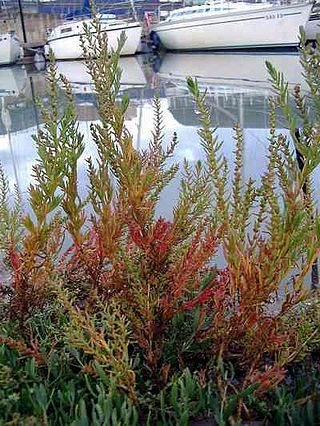
The Chenopodioideae are a subfamily of the flowering plant family Amaranthaceae in the APG III system, which is largely based on molecular phylogeny, but were included – together with other subfamilies – in the family Chenopodiaceae, or goosefoot family, in the Cronquist system.
Parodiodendron is a monotypic plant genus under the family Picrodendraceae, described as a genus in 1969. The sole species is Parodiodendron marginivillosum(Speg.) Hunz..

Suaeda is a genus of plants also known as seepweeds and sea-blites. Most species are confined to saline or alkaline soil habitats, such as coastal salt-flats and tidal wetlands. Many species have thick, succulent leaves, a characteristic seen in various plant genera that thrive in salty habitats.

Heliocarpus is a genus of flowering plants in the family Malvaceae. It was formerly classified in the Tiliaceae.

Tersonia is a genus of flowering plants in the family Gyrostemonaceae.

Carlo Luigi Spegazzini, in Spanish Carlos Luis Spegazzini, was an Italian-born Argentinian botanist and mycologist.

Dysphania is a genus of plants in the family Amaranthaceae. Species of the genus are found worldwide from the tropics and subtropics to warm-temperate regions.

Heterostachys is a genus of flowering plants in the plant family Amaranthaceae. The two species are shrubby halophytes native to South America and Central America.
Tournonia is a monotypic genus of flowering plants belonging to the family Basellaceae. It only contains one known species, Tournonia hookerianaMoq.

Henonia is a monotypic genus of flowering plants belonging to the family Amaranthaceae. It only contains one species, Henonia scoparia.
Delpinophytum is a monotypic genus of flowering plants belonging to the family Brassicaceae, with one species, Delpinophytum patagonicum(Speg.) Speg.
Hermbstaedtia is a genus of flowering plants belonging to the family Amaranthaceae.
Hochreutinera is a genus of flowering plants belonging to the family Malvaceae.
Parodiodoxa is a genus of flowering plants belonging to the family Brassicaceae. It just contains one species, Parodiodoxa chionophila(Speg.) O.E.Schulz
Sarcodraba is a genus of flowering plants belonging to the family Brassicaceae.

Herbstia is a monotypic genus of flowering plants belonging to the family Amaranthaceae. It only contains one species, Herbstia brasiliana(Moq.) Sohmer It is within the Amaranthoideae subfamily.

Horaninovia is a genus of flowering plants belonging to the family Amaranthaceae. It also belongs to the tribe Salsoleae as well as in the subfamily Salsoloideae.
Philippiella patagonica is a species of flowering plant belonging to the family Caryophyllaceae. It is the sole species in genus Philippiella.

Hammada is a genus of flowering plants belonging to the family Amaranthaceae. It is also in the Salsoloideae subfamily. Although it is a very unclear and unsorted genus with many species that have later been classed as synonyms.
Schreiteria is a monotypic genus of flowering plants belonging to the family Montiaceae. It is represented by the single species of Schreiteria macrocarpa(Speg.) Carolin. It is native to north-western Argentina.










